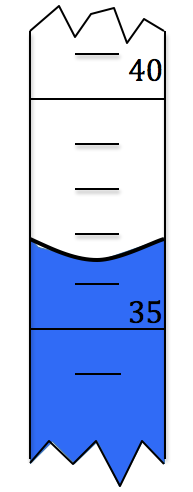Length measurement
Ruler
As you may already be aware, a ruler is the most simple method of measuring the length of an object. Most rulers are marked in centimeters or inches, and can measure to the nearest millimeter.
Micrometer screw gauge
Length measurements can be made more precise (compared to a ruler) by using a micrometer screw gauge. Whilst rulers measure to the nearest millimeter, a micrometer screw gauge can measure lengths to the nearest 1/100mm!
This instrument is therefore used to measure very small distances.
Volume measurement
A volume of a liquid can be determined by using a measuring cylinder. When reading the cylinder scale, it is important to measure from the bottom of the meniscus (i.e. bottom of the curve). Moreover, you must be directly parallel to it otherwise a parallax error may occur.

In the example above, the edge of the liquid reads at 37cm^3 but the miniscus is at 36.5cm^3 which is the true reading.
Time measurement
Clocks are devices that can be used to measure time. Although it can either be analogue or digital, most labs will use a digital one which can measure time to the nearest 0.01s.
Obtaining averages
Length measurements can be made more accurate by measuring multiples and averaging the results. For example, rather than measuring the thickness of one single sheet of paper, it would be more accurate to measure the thickness of 1000 sheets of paper and dividing the measurement by 1000.
This is also the case for time measurements (i.e. time taken for single pendulum swing). Instead of measuring the time taken for a single swing, it is much more accurate to measure the time taken for 100 swings and averaging the results.